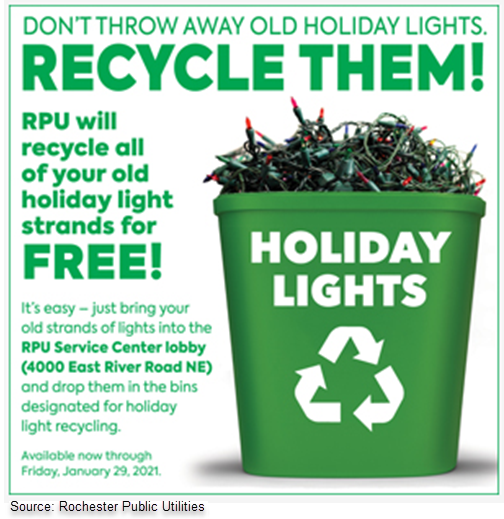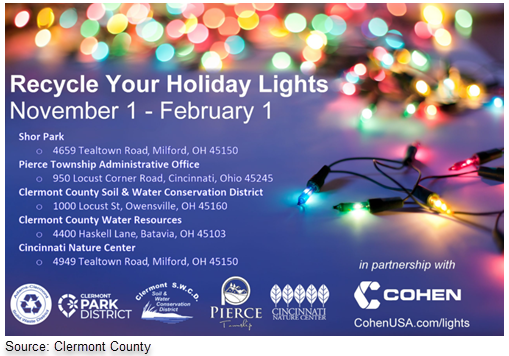
Americans are sending 2020 out in a blaze of Christmas-light glory. Compared to last year, they’ve already spent between 10% and 20% more on holiday décor, including lights. They started installing outdoor lights, erecting inflatable snowmen, and building tracks for tiny trains in early November. By Thanksgiving, they’d trimmed their Christmas trees and double-wrapped the branches with strings of white and multicolored bulbs.
Many of these Americans are still working from home during the pandemic, which means the holiday decorations at a lot of US households have been using electricity 24/7 for more than a month. Will Americans get burned when their utility bills are due?
By now, average consumers understand the cost-saving benefits of LEDs over incandescents. But even the most energy-efficient bulbs will use more energy if you run them for more hours. For various light displays, figures 1 and 2 compare energy usage and monthly costs for incandescent lights versus LEDs.
Figure 1: Typical energy usage and costs for standard incandescent and LED holiday lights
| Item | Watts | Cost per month |
|---|---|---|
| Note: Assumes 6 hours of daily use at $0.13 per kilowatt-hour. © E Source | ||
| 1 incandescent wreath | 21 | $0.50 |
| 1 LED wreath | 4 | $0.09 |
| 1,000 incandescent mini lights | 408 | $9.67 |
| 1,000 LED mini lights | 69 | $1.63 |
| 300 C9 incandescent bulbs | 2,100 | $49.86 |
| 300 C9 LED bulbs | 29 | $0.69 |
Figure 2: Typical energy usage and costs for minimal, moderate, and major incandescent and LED holiday displays
|
Typical energy usage and costs for minimal incandescent and LED holiday light displays<
|
||
|---|---|---|
| Item | Watts (incandescent) | Watts (LED) |
| Note: Assumes 6 hours of daily use at $0.13 per kilowatt-hour. © E Source | ||
| 1 wreath | 21 | 4 |
| 1 garland | 42 | 4 |
| 10 strings | 408 | 48 |
| 2 outdoor decorations | 164 | 38 |
| Total | 635 ($15.08/month) | 94 ($2.23/month) |
|
Typical energy usage and costs for moderate incandescent and LED holiday light displays<
|
||
| Item | Watts (incandescent) | Watts (LED) |
| 1 wreath | 63 | 14 |
| 500-foot C9 string on roof | 3,500 | 480 |
| 200-foot C9 string in yard | 1,400 | 192 |
| 30 strings for wrapping 2 trees | 1,224 | 144 |
| 15 strings for walkway trees | 612 | 72 |
| Total | 6,799 ($161.41/month) | 902 ($21.41/month) |
|
Typical energy usage and costs for major incandescent and LED holiday light displays<
|
||
| Item | Watts (incandescent) | Watts (LED) |
| 95 icicle lights | 6,056 | 458 |
| 800-foot C9 string on roof | 5,600 | 768 |
| 500-foot C9 string in yard | 3,500 | 480 |
| 15 strings for walkway trees | 612 | 72 |
| 10 strings for 1 light tree | 408 | 48 |
| 30 strings for wrapping 2 trees | 1,224 | 144 |
| 150-foot spool of rope light | 378 | 120 |
| 5 motifs | 554 | 277 |
| Total | 18,332 ($435.23/month) | 2,367 ($56.20/month) |
Set up LED holiday lighting programs now for brighter days in 2021
But what will happen to all these Christmas lights when 2020 gets sucked into the black hole where it belongs? We expect that in January and February 2021, people will recycle or trade in some of their older lights rather than store them in their basements or attics. It’s a good time for your utility to update or implement an LED holiday lighting program.
Using the E Source Measure Insights tool, which compiles and indexes information found in demand-side management technical reference manuals (TRMs) for 251 technologies across states, provinces, and regions, we found guidelines for LED holiday lighting programs in 6 of the 33 TRMs we track:
- California
- Hawaii
- Illinois
- Michigan
- Minnesota
- Pennsylvania
Some programs offer incentives that customers can redeem in the store when they’re buying their LED lights. Others include holiday LEDs in energy-efficiency kits or give them away during promotional campaigns. Still others allow customers to drop off their old incandescent lights in exchange for new LEDs.
When we dug into the details of the measures, we found a lot of variation in effective useful life (EUL), or the amount of time a piece of energy-efficient equipment is expected to last. The longer the EUL, the more savings the equipment will provide. Turns out that Pennsylvania and Michigan are the most optimistic about LED EULs, while Hawaii and California are more scroogey:
- California: 5 years
- Hawaii: 5 years
- Illinois: 7 years
- Michigan: 10 years
- Minnesota: 8 years
- Pennsylvania: 10 years
We also found that the average cost of a string of LEDs is between $12 and $22, and energy savings vary. The California TRM estimates that a 17-foot-by-25-foot string of C7 LED bulbs will save 4.2 kilowatt-hours (kWh) over its incandescent counterpart. The Pennsylvania TRM estimates that a 50-bulb string of LEDs will save 41.4 kWh over the equivalent incandescent string. There are also non-energy benefits related to LEDs: They last longer, they’re brighter, they have less heat buildup—making them safer to use indoors and on live trees—and they’re more durable because they use a plastic covering over the diode instead of a glass bulb.
Bid auld lang syne to 2020 by setting up light-recycling drop-offs
It’s not too late to set up lighting recycling stations. Rochester Public Utilities will keep its recycling center open until January 29, 2021. Clermont County in Ohio will accept unwanted Christmas lights until February 1, 2021 (figure 3). Thoughtful about COVID-19 restrictions, local utilities like Turlock Irrigation District in Northern California designated a window of time for residents to take part in its Holiday LED Light Exchange program in person at two area hardware stores. Municipalities such as the City of West Chicago in Illinois set up recycling bins in public buildings around the area for residents to drop off their used holiday lights. West Chicago will run its Holiday Lights Recycling program until January 17, 2021.

